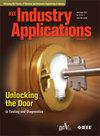通过处理分段静态电线中的闪络提高故障定位精度
IF 4.5
2区 工程技术
Q2 ENGINEERING, ELECTRICAL & ELECTRONIC
引用次数: 0
摘要
长期以来,使用基于阻抗的方法准确定位500千伏线路上的故障一直是弗吉尼亚道明能源公司面临的挑战。减少故障定位误差的系统方法效果良好;然而,单端、基于阻抗的方法总是返回不准确的故障位置。2020年初,我们经历了一次“啊哈”事件,改变了我们确定500千伏线路故障位置的方式。在我们的115和230千伏线路上,静态电线是连续的,而在500千伏线路上,它们是分段的,以减少损耗。当变电站的故障导致1区500千伏线路的远端跳闸时,数字故障记录仪(DFRs)错误地将故障位置报告在线路上。在利用已知位置对故障进行分析时,我们发现在某些故障中,分段的静态导线会在其分段点处闪过,使分段看起来是连续的。由此产生的零序阻抗与系统模型有很大的不同。基于这些信息,Dominion公司正在开发一种流程来计算其每条500千伏线路的闪络所需的故障电流水平。本文描述了我们发现的步骤,回顾了我们的故障定位方法,并讨论了基于已知位置确定故障定位的其他方法。我们进行了PSCAD研究来分析各种条件下的感应电压。本文章由计算机程序翻译,如有差异,请以英文原文为准。
Enhancing Fault Location Accuracy by Addressing Flashovers in Segmented Static Wires
Accurately locating faults on 500 kV lines using impedance-based methods has long been a challenge for Dominion Energy Virginia. Systems methods that were implemented to mitigate the fault location errors worked well; however, single-ended, impedance-based methods kept returning inaccurate fault locations. In early 2020, we experienced an “ah-ha” event that changed the way we determine fault location for 500 kV lines. While static wires are continuous on our 115 and 230 kV lines, for 500 kV lines they are segmented to reduce losses. When a fault in a substation caused the remote end of a 500 kV line to trip on Zone 1, the digital fault recorders (DFRs) incorrectly reported the fault location as being on the line. While using the known location to analyze the fault, we discovered that during certain faults segmented static wires would flash over at their segmentation points, causing the segments to appear continuous. The resulting zero-sequence impedance was vastly different than the system model. Based on this information, Dominion is developing a process to calculate the fault current levels required for flashover for each of its 500 kV lines. This paper describes the steps to our discovery, reviews our fault location methods, and discusses other methods of determining fault location based on a known location. We conducted a PSCAD study to analyze induced voltage under various conditions.
求助全文
通过发布文献求助,成功后即可免费获取论文全文。
去求助
来源期刊

IEEE Transactions on Industry Applications
工程技术-工程:电子与电气
CiteScore
9.90
自引率
9.10%
发文量
747
审稿时长
3.3 months
期刊介绍:
The scope of the IEEE Transactions on Industry Applications includes all scope items of the IEEE Industry Applications Society, that is, the advancement of the theory and practice of electrical and electronic engineering in the development, design, manufacture, and application of electrical systems, apparatus, devices, and controls to the processes and equipment of industry and commerce; the promotion of safe, reliable, and economic installations; industry leadership in energy conservation and environmental, health, and safety issues; the creation of voluntary engineering standards and recommended practices; and the professional development of its membership.
 求助内容:
求助内容: 应助结果提醒方式:
应助结果提醒方式:


